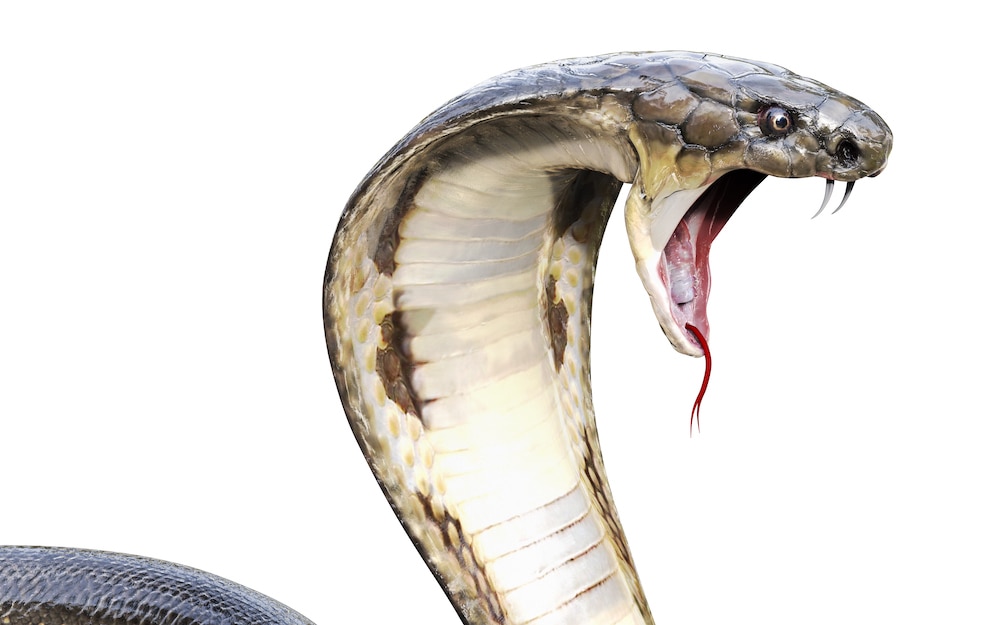Create a free profile to get unlimited access to exclusive videos, sweepstakes, and more!
Built-in antivenom meant our last common ancestor didn’t need to fear snakebites
Snake venom can kill, but the last common ancestor of humans, chimps & gorillas had amazing resistance.

Snake poison can kill, but the last (yet unidentified) common ancestor of humans, chimps, and gorillas had an unusually high resistance against cobra venom.
As they transitioned from climbing trees to walking upright on land, where they had a higher risk of potentially stepping on a snake, ancient primates in Africa and Asia developed resistance to the deadly neurotoxins that came out of those fangs. That doesn’t mean that you can mess with a cobra and necessarily come out alive. What it does mean is that humans have a much better chance of staying alive than other primates, at least long enough to get antivenom.
Researcher Bryan Fry of the University of Queensland in Australia, who recently coauthored a study published in BMC Biology, had to find out what caused this resistance. He and his colleagues ran tests with the venom and different artificial nerve receptors. Knowing that human ancestors were able to adapt to silent killers slithering on the ground adds proof to the theory that snakes have influenced primate evolution for a long time.
“These venoms bind to the alpha-1 nicotinic acetylcholine receptor,” he told SYFY WIRE. “This is the chemical email sent from the end of the nerves to the alpha-1 receptors located on the muscle surface which tells the muscle to contract.”
By taking over this receptor, the venom effectively paralyzes skeletal muscles and, more importantly, the diaphragm, which makes victims ultimately suffocate to death since they are not able to breathe. Whatever happened in the body of our prehistoric ancestors must have worked to prevent this binding and eventual paralysis somehow. Fry thinks that something known as a fitness disadvantage must have occurred in this creature. It can sometimes be a more positive phenomenon than it sounds. In this case, dysfunction meant prevention.
This primate is believed to have had receptors that didn't function normally, which turned the fitness disadvantage into an advantage since that also meant they did not pick up the full effect of the venom. Partial resistance was enough to keep early hominids alive without exhausting the body too much, so they were able to survive in snake-infested jungles. Such defenses only evolved where they were needed. Lemurs in Madagascar and monkeys in South America, which usually don’t run into killer venomous snakes, never developed such a resistance.
“With this fitness disadvantage, acetylcholine doesn’t bind as quickly to the modified receptors thus slowing down reaction time,” said Fry.
Of course, snakes had to have their revenge. Venom resistance in early hominids is probably the reason some cobras evolved their spitting abilities, so the poison severely irritates and inflames the eyes of a predator or perceived threat. The emergence of spitting in some cobra species was found to coincide with hominids and other primates walking on land. This sometimes keeps the snakes from getting snapped up by things that find them appetizing, such as birds, other mammals, and other reptiles, though they still may not escape the hungry jaws of a mongoose.
Primates dwelling on land still had an arsenal of weapons to fight off snakes. Opposable thumbs in Homo Erectus and others allowed for the creation of projectiles that could be thrown at snakes or primitive weapons that could otherwise fend them off. Other primates that got around on the ground were also capable of throwing things and screaming out alerts that were specific to snakes being nearby. Some cobras developed even more toxic venom in response to this, an evolutionary war that kept going back and forth between reptiles and primates.
“For this study we tested the whole venom, not parts of it. This allowed us to see the entire effect, thus replicating a snake bite,” Fry said. “Our work is a contribution is to evolutionary theory, but it does have the applied outcome of being a really kind of cool kind of science.”
Too bad we don’t live in the Harry Potter universe where you can just wave your wand and get rid of a poisonous fiend with the words “vipera evanesca.”


























